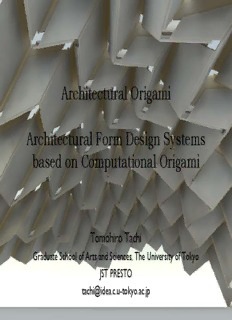
Architectural Origami Architectural Form Design Systems - courses PDF
Preview Architectural Origami Architectural Form Design Systems - courses
Architectural Origami Architectural Form Design Systems based on Computational Origami Tomohiro Tachi Graduate School of Arts and Sciences, The University of Tokyo JST PRESTO [email protected] 0 Introduction Background 1: Origami Running Hare 2008 Tetrapod 2009 Origami Teapot 2007 Tomohiro Tachi Tomohiro Tachi Tomohiro Tachi Background 2: Applied Origami • Static: – Manufacturing • Forming a sheet • No Cut / No Stretch Dome (Ron Resch) • No assembly – Structural Stiffness Table (T. Tachi and D. Koschitz) • Dynamic: – Deployable structure • Mechanism • Packaging Deployable Solar panels – Elastic Plastic Property (K. Miura) • Textured Material • Energy Absorption • Continuous surface Potentially useful for – Adaptive Environment – Context Customized Design – Personal Design – Fabrication Oriented Design Architectural Origami Pattern - 2D Pattern • Origami Architecture - Static Shape Direct application of Origami for Design – Design is highly restricted by the symmetry of the original pattern – Freeform design results in losing important property (origami-inspired design) Design Apply • Architectural Origami Origami theory for Design Conditions – Extract characteristics of origami - 3D shape in motion - Behavior – Obtain solution space of forms from the required condition and design context Outline 1. Origamizer – tucking molecules – layout algorithm 2. Freeform Origami – constraints of origami – perturbation based calculation – mesh modification 3. Rigid Origami – simulation – design by triangular mesh – design by quad mesh – non-disk? 1 Origamizer Related Papers: •Demaine, E. and Tachi, T. “Origamizer: A Practical Algorithm for Folding Any Polyhedron,” work in progress. •Tachi, T.,“Origamizing polyhedral surfaces,” IEEE Transactions on Visualization and Computer Graphics, vol. 16, no. 2, 2010. •Tachi, T., “Origamizing 3d surface by symmetry constraints,” August 2007. ACM SIGGRAPH 2007 Posters. •Tachi, T., “3D Origami Design based on Tucking Molecule,” in Origami4: A K Peters Ltd., pp. 259-272, 2009. Existing Origami Design Method by Circle Packing Circle River Method [Meguro 1992] Tree Method [Lang 1994] CP: Parent and Children Crabs by Toshiyuki Meguro Scutigera by Brian Chan 1D vs. 3D • Circle River Method / Tree Method – Works fine for tree-like objects – Does not fit to 3D objects • Origamizer / Freeform Origami – 3D Polyhedron, surface approximation – What You See Is What You Fold 3D Origami Laptop PC 2003 by Tomohiro Tachi not completed
Description: